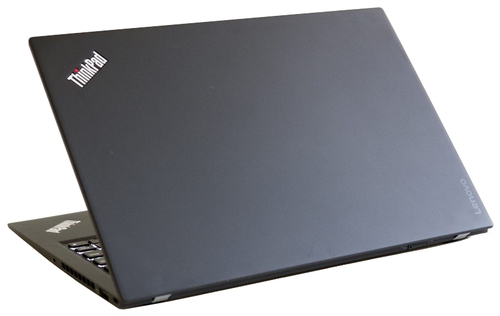Lenovo Thinkpad X1 Carbon 2017-20HR0021RT
Specifications

Price comparison
Reviews for the Lenovo Thinkpad X1 Carbon 2017-20HR0021RT
Source: Notebook-Center.ru
 RU→EN Archive.org version
RU→EN Archive.org versionPositive: Compact size; light weight; classical design; good hardware; nice connectivity; high autonomy.
Single Review, online available, Short, Date: 07/27/2017
Comment
Series: The Lenovo ThinkPad X1 Carbon 2017 is considered to be the most expensive and well recognized portable business notebook Lenovo has to offer and probably rightfully so since Lenovo acquired IBM’s PC division. What does this year’s X1 carbon has to offer in comparison to its competitor? It is powered by an Intel Core i7-7500U, up to 16 GB of soldered RAM, a super-fast 512 GB NVMe SSD, and a 14-inch IPS FHD panel. As the 7th Gen T4xx series has started to somewhat blur the difference between the X1 and the T4xx lineup, Lenovo practically had to go back to the drawing board to set it apart again starting with its chassis design. In terms of material choice, the X1 Carbon still uses a composite magnesium alloy for the base body with a matte rubbery feeling. This allows the X1 Carbon to maintain an extremely rigid, sturdy and rugged design. Unless you are intentionally applying a lot of pressure, the most you are going to be able to flex is the keyboard. However, in daily use this would never happen. The lid is made of a composite carbon fiber reinforced plastic, which might not be much of a comparison to the base chassis. However, it should be noted that you would still need a lot of force to intentionally warp or even damage it. Overall the chassis has really be well designed to meet its challenges. In terms of IO the X1 Carbon is well equipped with two USB type C Gen 2 connectors with Thunderbolt support, two full sized USB 3.0 type-A ports, a full sized HDMI video out, a mini Ethernet port,a microSD card reader and of course a headphone jack. When compared to other notebooks the only gripe is that the microSD card reader is a little hard to access without a SIM tool.
Naturally, as this is a business orientated notebook it also includes security features such as an integrated TPM 2.0 chip, a fingerprint reader and the usual Kensington lock. The only security feature missing here is a SmartCard reader which shouldn’t really be an issue since most of the common security features of a business notebook are already included. It should be noted that an optional IR camera can also be chosen, but it seems Lenovo has not started offering it yet. While the notebook is commonly shipped with your standard power adapter, Lenovo also offers a dock which is almost too commonly marketed with the Think lineup of notebooks. The optional docks are the USB C station dock and the newer Thunderbolt 3 station dock, with the latter being more feature-rich, but bulky in return. Moving over to the user inputs it is quite normal to say that the AccuType keyboard types like a wonder as in most Think series notebooks. However, the mechanics of this keyboard has been improved, while the previous generation of the keyboard felt a little shallow, the new improved version feels a bit deeper when it comes to key travel. This puts the X1 Carbon’s keyboard firmly at 1st place among most slim notebooks. As in most Think series notebooks, the signature track point and touchpad are a wonder to use. The glass touchpad remains nice to glide fingers on and is as accurate and precise as can be. One major point to emphasize here is that touchpad and click buttons remain separate, which should be the way, not the touchpad/clickpad combo nonsense most manufacturers are rolling out these days just to save costs. As for the trackpoint, the only honorable mention that can be done is it does its job as it was designed to.
As for the display, Lenovo actually offers two choices, the default FHD resolution panel with an option to choose the WQHD panel depending on the users need. Last on the list is the battery life. It is not surprising that X1 Carbon scored high. It achieved a battery lasting about 8 hours and 16 minutes on Wi-Fi and a whopping 11 hours and 9 minutes on video playback. The new 2017 X1 Carbon truly is a remarkable piece of hardware and is clearly well built with a focus on mobility.
Hands-on article by Jagadisa Rajarathnam
Intel HD Graphics 620: Integrated GPU (GT2) found on some Kaby-Lake CPU models (15 W ULV series).
Modern games should be playable with these graphics cards at low settings and resolutions. Casual gamers may be happy with these cards.
» Further information can be found in our Comparison of Mobile Graphics Cards and the corresponding Benchmark List.
i5-7200U: Kaby-Lake based SoC with two CPU cores clocked at 2.5 to 3.1 GHz, HyperThreading and manufactured with an improved 14nm process.» Further information can be found in our Comparison of Mobile Processsors.






